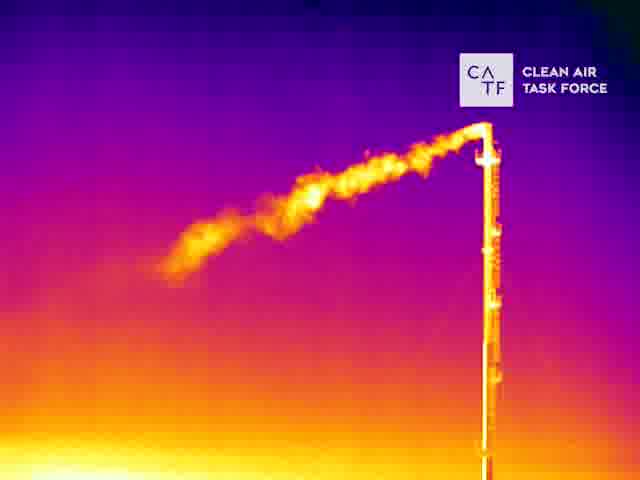Leaking methane from oil and gas infrastructure is widespread across the European continent, reveals an investigation of more than 150 sites in seven countries. More than 60 percent of the sites analyzed by researchers using state-of-the-art technology were releasing large volumes of methane – a powerful greenhouse gas – into the atmosphere.
This is the first large investigation of methane leakage from oil and gas sites in Europe.
“We’ve all been shocked by just how pervasive methane emissions are across Europe,” James Turitto, who filmed methane emissions for Clean Air Task Force (CATF), said in a statement. CATF is based in Boston but recently launched a European office.
Deploying an optical gas camera that uses infrared radiation to detect the typically invisible methane leaking from oil and gas infrastructure, CATF conducted a months-long investigation of fossil fuel sites in Europe. This type of camera is used widely by the oil and gas industry itself to find and detect leaks.
Images and video of methane leaks have been increasingly commonplace in places like the Permian basin, where environmental group Earthworks has extensively documented rampant methane leaks at drilling sites, drawing attention to a vast source of once-overlooked climate pollution.
But the documentation conducted by Turitto and CATF using an optical camera shows this isn’t confined to the Permian – it’s an international problem. On June 24, CATF released an online library of videos and data of its research, along with a new website.
“It’s clear that industry best practice is being ignored up and down the supply chain. Even as one person with an infrared camera, I’ve been able to find multiple leaks in every country I’ve visited. It begs the question – why aren’t the companies and national regulators doing this already?” Turitto said in a statement.
Turitto visited Austria, Czech Republic, Germany, Hungary, Italy, Poland, and Romania. He documented significant methane leaks at 123 of the 150 sites visited. Overall, more than 60 percent of the surveyed sites had significant concentrations of methane leaking. In some countries, that share stood at more than 90 percent of sites, with Italy and Hungary standing out as particular problems.
Europe is not a large producer of oil and gas, but it is the largest importer of both oil and gas and has an extensive pipeline network and storage facilities. It is at these sites – storage tanks, pipelines, liquefied natural gas import terminals – where methane is leaking in large volumes.
On a press call, Turitto said that a half-dozen or so sites really stood out as egregious polluters. An underground storage site in Minerbio, Italy, outside of Bologna, is the nation’s largest natural gas storage site. Owned by a subsidiary of Snam, the largest gas storage operator in Italy, the site had a single stack approximately 200 to 250 feet tall that was venting methane in massive quantities.

Venting, as opposed to flaring, is much worse for the climate. Flaring burns the methane, turning it into carbon dioxide, whereas venting releases methane directly into the atmosphere, where it traps heat more intensely, and more quickly than CO2.
Turitto said he was immediately struck by the size and height of the venting stack. “It occupied most of my time to document this. I didn’t spend too much other time looking at the rest of the site because the sheer amount of methane that is being emitted from this central stack is enormous,” Turitto said. “This is the largest [source of] emissions that I’ve found so far in Europe from one particular site.”
In a statement to Reuters, Snam said the venting documented by Turitto at its Minerbio site was the result of equipment malfunction that it intended to fix later this year.
Another prominent source of methane emissions was an LNG import terminal in La Spezia, Italy, near the picturesque hills of Cinque Terre, an international tourist destination. Turitto captured two vents on camera releasing large volumes of methane. He documented other sizable sources of methane pollution at fossil fuel infrastructure in Germany and Hungary.

One of the limitations of the investigation is that the optical camera cannot quantify with precision how much methane is being released from a stack or storage facility. It’s a “qualitative tool,” Turitto said, allowing for the detection of large methane releases, but “we can’t make detailed, accurate quantification estimates of the emissions,” he said.
Turitto said that CATF has reached out to other researchers from around the world, and “the consensus seems to be that this is on the higher scale of what they have seen as well,” Turitto said, referring to the images of the pollution at Snam’s site in Minerbio, Italy.
Turitto plans on expanding the investigation to more countries across Europe in the coming months.
A recent study by the National Oceanic and Atmospheric Administration (NOAA) found that global methane concentrations increased by a record amount in 2020.
“The footage reminds us that methane emissions is very much a European problem, that it concerns all member states. None of the countries visited so far was exempted from it,” said Alessia Virone, government affairs manager at CATF. “So, if we want to really see a solution, we need to look at the European level.” CATF pointed to a petition that calls on the European Union to take action to cut methane pollution.
In October 2020, the EU announced its Methane Strategy, kicking off a process that is expected to result in a final legislative proposal in the fourth quarter of this year. Currently, methane pollution from energy companies is not regulated by the EU, but the EU has signaled that it will require companies to detect and plug leaks when the new rules eventually become law.
There are a few things that Europe can do, Virone said. The European Commission should ban venting and flaring. Standards should also be put on imports of oil and gas, so that producers outside of Europe have to clean up their act as well. Europe should also explore a global agreement on methane pollution at the international level, she said.
“It’s more concerning for me than I honestly thought. I think we are seriously underestimating the level of methane emissions especially from the oil and gas industry,” Martin Hojsík, a member of the European Parliament from Slovakia, told reporters.
“We have to figure out a mechanism of how to include methane emissions in the final price of imported oil and gas,” Hojsík said.
Hojsík expressed frustration that the European Commission was merely considering some regulations on methane. “There is completely no way we can permit routine venting and flaring. This practice simply needs to be banned. We don’t have time anymore to consider actions. We need to act now,” he said.
“We need concrete measures. Not more assessments, feasibility studies, impact assessments, vague statements, strategies,” Hojsík said. “We need binding legislation.”
Subscribe to our newsletter
Stay up to date with DeSmog news and alerts







